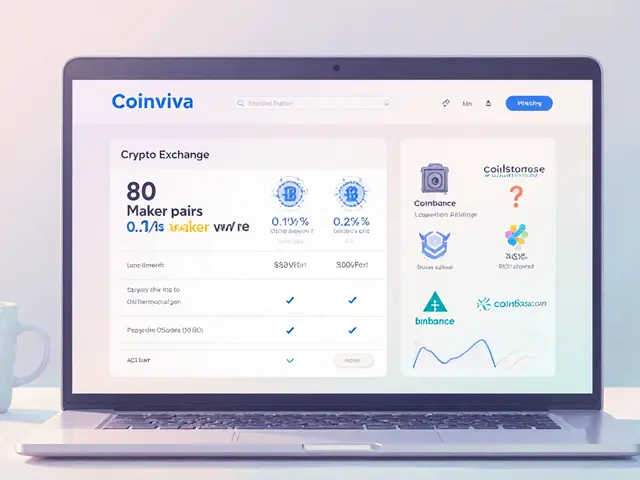Crypto Bear Market Duration: How Long Do They Last?

Crypto Bear Market Duration Calculator
Estimated Bear Market Duration
Historical Context
Average duration: 9.6-10 months
Shortest recorded: 4-5 months
Longest recorded: 1 year 8 months
When crypto prices tumble 20% or more and stay low for months, investors start asking the same question: crypto bear market duration. Knowing how long a crypto winter typically lasts helps you set realistic expectations, plan buying opportunities, and avoid panic‑driven mistakes.
What exactly is a crypto bear market?
Crypto Bear Market is a prolonged period where cryptocurrency prices fall at least 20% from recent highs, accompanied by falling confidence, low trading volumes, and supply outpacing demand. The term "crypto winter" is often used interchangeably, especially in community guides that emphasize the psychological strain during these phases.
Historical patterns: how long have past crypto bear markets lasted?
Data from multiple analysts paint a fairly narrow band. The average bear market runs about 9.6-10 months, with the shortest observed at 4‑5 months and the longest stretching to 1 year8 months. Notable examples include:
- 2017‑2018 bear market - roughly 13 months after Bitcoin’s peak.
- Nov2021-Jan2023 bear market - 14 months, Bitcoin fell 75.9% from $69k to $16.5k.
- 2022‑2023 downturn - 12‑13 months, the longest recorded in recent history.
These cycles align closely with Bitcoin’s Halving Cycle is an event occurring every 210,000 blocks (≈4years) that cuts the block reward in half, historically triggering a bull run followed by a bear market. After each halving, analysts have spotted a 12‑18 month bull phase and a 13‑14 month bear phase.

Key factors that stretch or shrink a bear market
Four main drivers shape the length of a crypto winter:
- Market sentiment - Fear & greed indices, social media chatter, and on‑chain stress metrics (NUPL, MVRV) can accelerate sell‑offs when fear spikes.
- Regulatory developments - New frameworks (e.g., MiCA in Europe, SEC rulings on ETFs) either calm investors or reignite uncertainty.
- Institutional participation - Large holders such as BlackRock’s spot Bitcoin ETF provide steady buying pressure, which tends to shorten downturns.
- Technical indicators - Support levels, moving‑average crossovers, and RSI trends often dictate when “bottom‑fishing” occurs, typically 4‑6 months into a bear market.
When sentiment stays negative for a long stretch, bear markets linger. Conversely, a flurry of institutional buying or a clear regulatory win can truncate the slump to as little as six months.
How crypto bear markets compare to traditional markets
Traditional equity bear markets average 1‑2 years, with the longest lasting three years (1946‑1949). Crypto’s maximum of 1year8months is noticeably shorter, but the price drops are steeper - a 75% Bitcoin decline versus a typical 25‑57% stock market loss.
| Metric | Crypto (Average) | Traditional (S&P500) |
|---|---|---|
| Duration | 9.6‑10months | 12‑24months |
| Typical Drawdown | ≈55‑75% | ≈25‑57% |
| Liquidity Impact | Sharp drops in volume, higher volatility | Gradual volume decline, lower volatility |
| Recovery Time (to pre‑bear peak) | ≈2.7years (≈1,000days) | ≈1‑2years |
While crypto bull phases often outpace traditional ones in speed, the severe corrections make timing critical.

Looking ahead: will bear market length change?
Recent data suggests the classic 13‑14 month crypto winter may be shrinking. A Bloomberg survey of 12 major institutions forecasts an average next‑cycle duration of 8.2months, down from the historical 9.8months. Contributors to this shift include:
- Higher institutional % of supply - now ~27% of Bitcoin’s circulating supply, providing a stabilizing floor.
- More mature derivatives markets - allowing hedging and reduced panic selling.
- Improved regulatory clarity - European MiCA and the U.S. ETF framework lower uncertainty.
However, analysts caution that regulatory setbacks or a sudden macroeconomic shock could push durations back up. The consensus is a modest pull‑back to 6‑8months for the next cycle, but volatility will still be a factor.
Practical checklist for navigating a crypto bear market
- Maintain a stablecoin reserve - 3‑6months of living expenses to seize dip buying opportunities.
- Track Market Sentiment is measured via fear & greed indices, social media volume, and on‑chain stress signals. Enter new positions when sentiment scores drop below 20.
- Use technical entry points - look for RSI hovering in the 30‑40 range and price testing a 200‑day moving average.
- Diversify across assets - add exposure to Bitcoin, Ethereum, and a handful of high‑quality layer‑1s to mitigate single‑asset risk.
- Watch regulatory headlines - a positive ruling can shorten the slump, while a crackdown may extend it.
- Limit leverage - data shows 87% of liquidations during the 2022 bear market came from >10x leverage positions.
- Review institutional flow - large inflows into ETFs or custodial services often signal a floor forming.
By treating a bear market as a structured phase rather than a panic event, you can stay disciplined and potentially come out ahead when the next bull run begins.
Frequently Asked Questions
What defines a crypto bear market?
A crypto bear market is a sustained decline of at least 20% from a recent peak, marked by decreasing confidence, lower trading volumes, and a supply‑demand imbalance.
How long do most crypto bear markets last?
Historical data shows an average duration of roughly 9½‑10months, with the shortest lasting about 4‑5months and the longest about 20months.
Does the Bitcoin halving affect bear market length?
Yes. Each halving traditionally triggers a 12‑18month bull run followed by a 13‑14month bear phase, though recent cycles hint the bear period may be shortening.
Can institutional investors shorten a crypto winter?
Increasing institutional holdings (now about 27% of Bitcoin’s supply) provide consistent buying pressure that can reduce the duration of a downturn, potentially to 6‑8months.
What practical steps should I take during a bear market?
Keep a stablecoin reserve, monitor market sentiment, use technical entry signals (RSI 30‑40, 200‑day MA), limit leverage, and stay informed on regulatory changes.







The recent analysis provides a comprehensive overview of the typical duration of cryptocurrency bear markets.
Historical data indicate an average length of approximately nine to ten months, which aligns with the figures presented in the article.
It is important to recognize that this average is a statistical midpoint rather than a deterministic rule.
Individual market cycles can deviate considerably depending on macro‑economic conditions, regulatory developments, and institutional participation.
For instance, the 2017‑2018 bear market persisted for roughly thirteen months, whereas some shorter corrections lasted merely four to five months.
The influence of the Bitcoin halving cycle remains a salient factor, as each halving has historically been followed by a bull phase lasting twelve to eighteen months and a subsequent bear phase of thirteen to fourteen months.
Nevertheless, recent trends suggest a modest contraction in bear‑market duration, potentially attributable to increased institutional ownership and more mature derivatives markets.
A Bloomberg survey referenced in the article forecasts an average future duration of eight point two months, which represents a slight reduction from the historical average of nine point eight months.
Investors should therefore consider a flexible outlook rather than an inflexible expectation of a fixed timeframe.
Maintaining a stablecoin reserve equivalent to three to six months of living expenses can provide the liquidity necessary to capitalize on buying opportunities that arise during market lows.
Monitoring sentiment metrics such as the Fear & Greed Index, on‑chain stress indicators, and social‑media volume can help identify optimal entry points.
Technical analysis suggests that price action near the 200‑day moving average combined with an RSI in the 30‑40 range frequently precedes a bottoming process.
Moreover, tracking large inflows into institutional products like spot Bitcoin ETFs can serve as a proxy for emerging floor support.
While the data presented is robust, it is essential to remain vigilant for unforeseen regulatory announcements that could extend market downturns.
In summary, the average bear‑market duration remains around ten months, but contemporary factors may compress this window to six‑to‑eight months in forthcoming cycles.
By adhering to disciplined risk management and leveraging the tools highlighted above, investors can navigate the crypto winter with greater confidence.
The article reminds us that bear markets are not merely statistical artifacts but reflections of collective psychology.
When sentiment swings towards fear, liquidity dries up and price corrections accelerate.
Conversely, a measured infusion of institutional capital can act as a stabilizing force.
Therefore, understanding the interplay between sentiment and institutional participation is essential for any long‑term investor.
Wow!!! This piece really nails the numbers-9‑10 months on average, give or take!!!
But let’s be real: every cycle has its own quirks, and we can’t just slap a ruler on it!!!
Regulatory shocks can knock the duration up, while ETF inflows can slash it down!!!
Stay flexible, stay vigilant, and ride the wave!!!
Remember: the only constant is change!!!
Yooo I read the chartz and it’s like… the bear markets are sooo variable!!!
One time it’s 4 months, next it’s 13‑14, like a rollercoaster lol.
Regulashun news can totally flip the script, you feel me??
And those insti‑titionals? They’re like the safety net that sometimes ain’t there.
Anyway, keep those stablecoins ready, it’s a wild ride out there!
Don’t forget to check the fear‑&‑greed index, it’s a vibe.
I appreciate the thorough breakdown of bear‑market timelines.
The historical averages give a useful baseline, yet the emphasis on adaptability is key.
Keeping a stablecoin reserve and monitoring sentiment metrics can indeed smooth the experience.
It’s also wise to stay aware of regulatory developments that could shift expectations.
Overall, a balanced approach grounded in data and flexibility serves investors well.
When the crypto winter bites, the drama hits its peak!
Imagine the markets trembling as fear spreads, yet beneath that chill lies the promise of spring.
Storing stablecoins becomes a heroic act, a beacon of hope amid the freeze.
Technical signals like the 200‑day moving average whisper the tale of an approaching rebound.
Institutions stepping in are the unsung guardians that can thaw the frost.
Hold fast, stay disciplined, and let the eventual sunrise illuminate your portfolio!